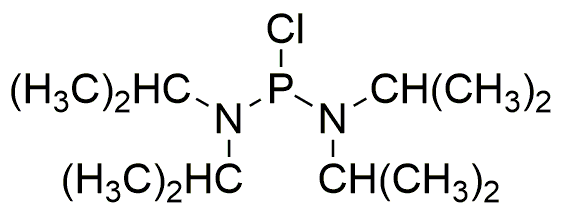Bis(diisopropylamino)chlorophosphine is widely utilized in research focused on:
- Pharmaceutical Development: This compound serves as a key intermediate in the synthesis of various pharmaceuticals, particularly in the development of drugs targeting neurological disorders due to its ability to modify phosphorous-containing structures.
- Agricultural Chemicals: It is used in the formulation of agrochemicals, enhancing the efficacy of pesticides and herbicides by improving their stability and bioavailability in various environmental conditions.
- Organophosphorus Chemistry: Researchers employ this compound in the study of organophosphorus compounds, facilitating the development of new materials with unique properties, such as flame retardants and plasticizers.
- Analytical Chemistry: It acts as a reagent in analytical methods for detecting and quantifying nitrogen and phosphorus compounds, providing precise measurements essential for environmental monitoring.
- Polymer Science: The compound is utilized in the synthesis of specialty polymers, where its unique chemical properties contribute to enhanced performance characteristics, such as improved thermal stability and mechanical strength.
General Information
Properties
Safety and Regulations
Applications
Bis(diisopropylamino)chlorophosphine is widely utilized in research focused on:
- Pharmaceutical Development: This compound serves as a key intermediate in the synthesis of various pharmaceuticals, particularly in the development of drugs targeting neurological disorders due to its ability to modify phosphorous-containing structures.
- Agricultural Chemicals: It is used in the formulation of agrochemicals, enhancing the efficacy of pesticides and herbicides by improving their stability and bioavailability in various environmental conditions.
- Organophosphorus Chemistry: Researchers employ this compound in the study of organophosphorus compounds, facilitating the development of new materials with unique properties, such as flame retardants and plasticizers.
- Analytical Chemistry: It acts as a reagent in analytical methods for detecting and quantifying nitrogen and phosphorus compounds, providing precise measurements essential for environmental monitoring.
- Polymer Science: The compound is utilized in the synthesis of specialty polymers, where its unique chemical properties contribute to enhanced performance characteristics, such as improved thermal stability and mechanical strength.
Documents
Safety Data Sheets (SDS)
The SDS provides comprehensive safety information on handling, storage, and disposal of the product.
Product Specification (PS)
The PS provides a comprehensive breakdown of the product’s properties, including chemical composition, physical state, purity, and storage requirements. It also details acceptable quality ranges and the product's intended applications.
Certificates of Analysis (COA)
Search for Certificates of Analysis (COA) by entering the products Lot Number. Lot and Batch Numbers can be found on a product’s label following the words ‘Lot’ or ‘Batch’.
*Catalog Number
*Lot Number
Certificates Of Origin (COO)
This COO confirms the country where the product was manufactured, and also details the materials and components used in it and whether it is derived from natural, synthetic, or other specific sources. This certificate may be required for customs, trade, and regulatory compliance.
*Catalog Number
*Lot Number
Safety Data Sheets (SDS)
The SDS provides comprehensive safety information on handling, storage, and disposal of the product.
DownloadProduct Specification (PS)
The PS provides a comprehensive breakdown of the product’s properties, including chemical composition, physical state, purity, and storage requirements. It also details acceptable quality ranges and the product's intended applications.
DownloadCertificates of Analysis (COA)
Search for Certificates of Analysis (COA) by entering the products Lot Number. Lot and Batch Numbers can be found on a product’s label following the words ‘Lot’ or ‘Batch’.
*Catalog Number
*Lot Number
Certificates Of Origin (COO)
This COO confirms the country where the product was manufactured, and also details the materials and components used in it and whether it is derived from natural, synthetic, or other specific sources. This certificate may be required for customs, trade, and regulatory compliance.

